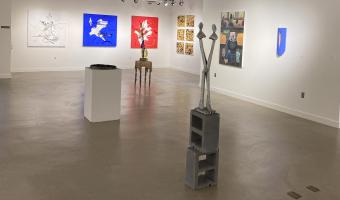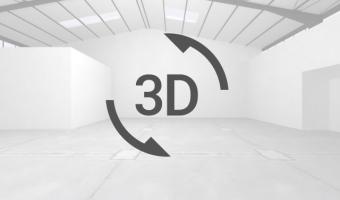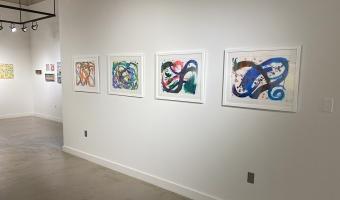Haunted Terrain
Haunted Terrain - what is it? A landscape permeated by ghosts? A particular place? Or does it exist primarily in the imagination?
Try thinking of it as a state of mind regarding the curious, the disturbing, the sublime, and the visionary.
A futuristic “observatory” in Japan is buried a half-mile deep in solid rock, notes Robert Macfarlane in Underland. Its stainless steel tanks hold 50,000 tons of ultra-pure water. Thirteen-thousand photomultiplier tubes scan the tank for the blue cone shadow of “ghost particles”—electrons moving faster than the speed of light through the water. The purpose of the site is to gather evidence of exploding super-novae from distant corners of the Milky Way.
Beneath a vast, otherworldly volcanic landscape lies Derinkuyu, an ancient
subterranean city on the Anatolian Plateau. For more than a thousand years
persecuted minorities sought refuge in its network of rooms and passages. Twenty-thousand people could live in this secret city indefinitely.
Tibet’s hidden falls of Tsangpo Gorge were not explored until the late 20th-century. The world’s deepest and most inaccessible canyon is revealed as sacred territory by an-cient Buddhist texts. Somewhere in the canyon is a portal to a mystical paradise— the origin of the legend of Shangri-La.
Though these places sound fantastical they are real.
In this show, artists reimagine such haunted terrain or invent their own out of whole cloth. Some are inspired by the cataclysms or traumas of history. More than a hint of the Romantic spirit is embedded in the exhibition’s post-Modernist work.
Marcel Proust said, “The real journey of discovery consists not in seeking new landscapes, but in having new eyes.”
Anonda Bell considers our fraught relationship with the natural world. In Biophobia, Skin, a swarm of critters envelope their natural habitat - the human body. Despite her inclination to shock us with reality, Bell dismisses an urge to avoid the creepy side of life, and instead advocates for embracing nature, warts and all. “Many children spend more time with screens than dirt,” she says. Truth be told, this goes for virtually every-one.
Farther down the wall, Bell imagines a dystopian Eden featuring Lilith, Adam’s first wife. She sports a coat of many microbes, and appears decidedly the worse for wear. Lilith refused to be subservient to the first man and was branded as a she-demon and was
cast out. (Natch.)
In Frida Bug, Santiago Cohen reimagines the iconic Frida Kahlo encased in a
resplendent black wasp body. It’s like the mother space monster in the film Aliens, but funnier and at least as dark. It is Cohen’s bittersweet homage to Kahlo. Cohen says, “Frida Bug is indeed like a metamorphosis of Frida, from a revolutionary person with
socialist values to a commercial icon of modern society. You can find her image all over the world in plates, keychains, T-shirts. It is sad.”
Many of the participating artists invent their own worlds. Utopian or dystopian. Looking back or to the future. In TwentyTwenty Josh Dorman does both depicting a distressed past, and envisioning life enclosed in a bubble as our likely fate.
“If we opened people up, we would find landscapes,” Agnes Varda observed in her autobiographical film,Varda by Agnes. Startling and hyperbolic—but recent science has uncovered remarkable evidence of how the human brain processes our passage through space, and how central to our being that awareness is.
We are master explorers. A bio-compass that uses the Earth’s magnetic fields allows birds and other animals to find their way. We have an even better tool—a mind that enables us to tell stories both backward and forward in time. We can remember what we saw in the past, and we can envision how that experience can shape our future. Caroline Islanders of Micronesia developed the ability to find land by reading wave swells in the open ocean.
For an artist to be a purposeful explorer is useful, but to be a wanderer—risking getting lost—is essential. The artists in this exhibition recognize the value of getting “lost in the woods,” as Thoreau puts it in Walden. There is much of that impulse for consideration here.
Jim Jarmusch gives Thoreau's words a twist: “It’s hard to get lost, if you don’t know where you’re going.” These artists are wandering explorers who mine and map the past and consider the future in their work. Artists as dream geographers are authors, in Sandy Skoglund's words, of “true fiction.”
Participating Artists:
Anonda Bell Robert Gould
Mashell Black Victoria Manning
John Bradford
Sandy Skoglund
Santiago Cohen
Linda Streicher
Josh Dorman
Daniel Wiener
Curator: Peter Delman
Try thinking of it as a state of mind regarding the curious, the disturbing, the sublime, and the visionary.
A futuristic “observatory” in Japan is buried a half-mile deep in solid rock, notes Robert Macfarlane in Underland. Its stainless steel tanks hold 50,000 tons of ultra-pure water. Thirteen-thousand photomultiplier tubes scan the tank for the blue cone shadow of “ghost particles”—electrons moving faster than the speed of light through the water. The purpose of the site is to gather evidence of exploding super-novae from distant corners of the Milky Way.
Beneath a vast, otherworldly volcanic landscape lies Derinkuyu, an ancient
subterranean city on the Anatolian Plateau. For more than a thousand years
persecuted minorities sought refuge in its network of rooms and passages. Twenty-thousand people could live in this secret city indefinitely.
Tibet’s hidden falls of Tsangpo Gorge were not explored until the late 20th-century. The world’s deepest and most inaccessible canyon is revealed as sacred territory by an-cient Buddhist texts. Somewhere in the canyon is a portal to a mystical paradise— the origin of the legend of Shangri-La.
Though these places sound fantastical they are real.
In this show, artists reimagine such haunted terrain or invent their own out of whole cloth. Some are inspired by the cataclysms or traumas of history. More than a hint of the Romantic spirit is embedded in the exhibition’s post-Modernist work.
Marcel Proust said, “The real journey of discovery consists not in seeking new landscapes, but in having new eyes.”
Anonda Bell considers our fraught relationship with the natural world. In Biophobia, Skin, a swarm of critters envelope their natural habitat - the human body. Despite her inclination to shock us with reality, Bell dismisses an urge to avoid the creepy side of life, and instead advocates for embracing nature, warts and all. “Many children spend more time with screens than dirt,” she says. Truth be told, this goes for virtually every-one.
Farther down the wall, Bell imagines a dystopian Eden featuring Lilith, Adam’s first wife. She sports a coat of many microbes, and appears decidedly the worse for wear. Lilith refused to be subservient to the first man and was branded as a she-demon and was
cast out. (Natch.)
In Frida Bug, Santiago Cohen reimagines the iconic Frida Kahlo encased in a
resplendent black wasp body. It’s like the mother space monster in the film Aliens, but funnier and at least as dark. It is Cohen’s bittersweet homage to Kahlo. Cohen says, “Frida Bug is indeed like a metamorphosis of Frida, from a revolutionary person with
socialist values to a commercial icon of modern society. You can find her image all over the world in plates, keychains, T-shirts. It is sad.”
Many of the participating artists invent their own worlds. Utopian or dystopian. Looking back or to the future. In TwentyTwenty Josh Dorman does both depicting a distressed past, and envisioning life enclosed in a bubble as our likely fate.
“If we opened people up, we would find landscapes,” Agnes Varda observed in her autobiographical film,Varda by Agnes. Startling and hyperbolic—but recent science has uncovered remarkable evidence of how the human brain processes our passage through space, and how central to our being that awareness is.
We are master explorers. A bio-compass that uses the Earth’s magnetic fields allows birds and other animals to find their way. We have an even better tool—a mind that enables us to tell stories both backward and forward in time. We can remember what we saw in the past, and we can envision how that experience can shape our future. Caroline Islanders of Micronesia developed the ability to find land by reading wave swells in the open ocean.
For an artist to be a purposeful explorer is useful, but to be a wanderer—risking getting lost—is essential. The artists in this exhibition recognize the value of getting “lost in the woods,” as Thoreau puts it in Walden. There is much of that impulse for consideration here.
Jim Jarmusch gives Thoreau's words a twist: “It’s hard to get lost, if you don’t know where you’re going.” These artists are wandering explorers who mine and map the past and consider the future in their work. Artists as dream geographers are authors, in Sandy Skoglund's words, of “true fiction.”
Participating Artists:
Anonda Bell Robert Gould
Mashell Black Victoria Manning
John Bradford
Sandy Skoglund
Santiago Cohen
Linda Streicher
Josh Dorman
Daniel Wiener
Curator: Peter Delman


